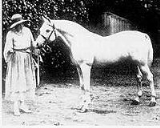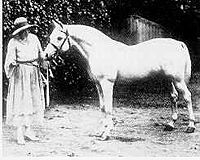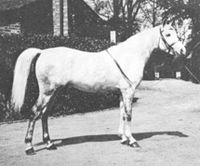
Skowronek
Encyclopedia

Arabian horse
The Arabian or Arab horse is a breed of horse that originated on the Arabian Peninsula. With a distinctive head shape and high tail carriage, the Arabian is one of the most easily recognizable horse breeds in the world. It is also one of the oldest breeds, with archaeological evidence of horses...
stallion
Stallion (horse)
A stallion is a male horse that has not been gelded .Stallions will follow the conformation and phenotype of their breed, but within that standard, the presence of hormones such as testosterone may give stallions a thicker, "cresty" neck, as well as a somewhat more muscular physique as compared to...
foaled in 1909. He was bred by Count Józef Potocki
Potocki
Potocki is the surname of a Polish noble family.-History:The Potocki family is a great artistocratic family originated from Potok in the Kraków Voivodeship; their family name derives from that place name. The family is heavily entwined with the cultural development and history of Poland's Eastern...
who owned the Antoniny Stud in Poland
Poland
Poland , officially the Republic of Poland , is a country in Central Europe bordered by Germany to the west; the Czech Republic and Slovakia to the south; Ukraine, Belarus and Lithuania to the east; and the Baltic Sea and Kaliningrad Oblast, a Russian exclave, to the north...
. He was imported to England
England
England is a country that is part of the United Kingdom. It shares land borders with Scotland to the north and Wales to the west; the Irish Sea is to the north west, the Celtic Sea to the south west, with the North Sea to the east and the English Channel to the south separating it from continental...
as a young horse. Upon purchase by Lady Wentworth
Judith Blunt-Lytton, 16th Baroness Wentworth
Judith Anne Dorothea Blunt-Lytton, 16th Baroness Wentworth also known as Lady Wentworth was a British peeress, Arabian horse breeder and tennis player...
, Skowronek became a foundation stallion at Lady Wentworth's famed Crabbet Arabian Stud
Crabbet Arabian Stud
The Crabbet Arabian Stud, also known as the Crabbet Park Stud, was a horse breeding farm established on 2 July 1878 when the first Arabian horses brought to England by Wilfrid Scawen Blunt and Lady Anne Blunt arrived at Crabbet Park, their estate in Sussex...
. He was most often crossed on mare
Mare (horse)
A mare is an adult female horse or other equine.In most cases, a mare is a female horse over the age of three, and a filly is a female horse age three and younger. However, in Thoroughbred horse racing, a mare is defined as a female horse more than four years old; in harness racing a mare is a...
s who were daughters or granddaughters of the stallion Mesaoud
Mesaoud
Mesaoud, an Arabian stallion, foaled 1887, was one of the foundation sires of the Crabbet Arabian Stud in England. Bred in Egypt by Ali Pasha Sherif, he was imported to England by Wilfred and Lady Anne Blunt in 1891...
, another foundation stallion for Crabbet, who had been bred by Ali Pasha Sherif
Ali Pasha Sherif
Ali Pasha Sherif was an Egyptian government official and a renowned breeder of Arabian horses during the late 19th century.-Family Background:...
and imported from Egypt
Egypt
Egypt , officially the Arab Republic of Egypt, Arabic: , is a country mainly in North Africa, with the Sinai Peninsula forming a land bridge in Southwest Asia. Egypt is thus a transcontinental country, and a major power in Africa, the Mediterranean Basin, the Middle East and the Muslim world...
to England by Lady Wentworth's parents, Wilfrid
Wilfrid Scawen Blunt
Wilfrid Scawen Blunt was an English poet and writer. He was born at Petworth House in Sussex, and served in the Diplomatic Service from 1858 to 1869. His mother was a Catholic convert and he was educated at Twyford School, Stonyhurst and at St Mary's College, Oscott...
and Lady Anne Blunt
Lady Anne Blunt
Anne Isabella Noel Blunt, née King-Noel, 15th Baroness Wentworth , known for most of her life as Lady Anne Blunt, was co-founder, with her husband the poet Wilfrid Scawen Blunt, of the Crabbet Arabian Stud. The two married on 8 June 1869...
.
Skowronek was a gray
Gray (horse)
Gray or grey is a coat color of horses characterized by progressive silvering of the colored hairs of the coat. Most gray horses have black skin and dark eyes; unlike many depigmentation genes, gray does not affect skin or eye color Their adult hair coat is white, dappled, or white intermingled...
stallion, on the small side, noted for his outstanding Arabian type, particularly his fine head and overall correct conformation. Lady Wentworth preferred to breed taller Arabians, but also wanted to preserve Arabian type and beauty, and Skowronek helped her accomplish this goal.
Early background

Walter Winans
Walter W. Winans was an American marksman, horse breeder, sculptor, and painter who participated in the 1908 and 1912 Summer Olympics. He won two medals for shooting: a gold in 1908 and a silver in 1912. He also won a gold medal for his sculpture An American Trotter at Stockholm in 1912...
bought Skowronek from Count Josef Potocki's Antoniny Stud. Winas had originally gone to Poland to hunt game at Count Potocki's private animal park, Piławin, located north of Antoniny, where he spotted the gray stallion and purchased him for 150 pounds. Winans rode the stallion and used him as a model for several bronzes, then sold Skowronek to Mr. Webb Wares, "who rode him as a hack," and eventually sold him to H.V. Musgrave Clark, where he was shown and used at stud for the first time, coming to the attention of Lady Wentworth.
Lady Wentworth bought the Skowronek under circumstances that remain a bit confusing even today. Clark believed he was selling the horse to an American exporter, but at the last minute, the export was cancelled and Lady Wentworth suddenly was the owner of Skowronek. Clark was a rival Arabian breeder, and Lady Wentworth may have used the agent as a front; concerned that if Clark had known she was interested, he may have increased the price - or refused to sell the horse at all. Clark was not happy with the result, and the two breeders had a somewhat cool relationship after she purchased the stallion.
While Count Potocki apparently found Skowronek unimpressive as a colt, having sold him to Winans for a relatively low price, he matured into a very fine stallion. Lady Wentworth later turned down an offer of $250,000 from the Tersk Stud
Tersk Stud
The Tersk Stud was officially established on February 11, 1921, on the orders of Marshal Semyon Budyonny. The breeding farm was used to restore the Russian horse population, which suffered heavy losses during the Russian Revolution.- Early history :...
in the Soviet Union
Soviet Union
The Soviet Union , officially the Union of Soviet Socialist Republics , was a constitutionally socialist state that existed in Eurasia between 1922 and 1991....
and bragged that she once received a cable "from the Antipodes" addressed to "Skowronek, England." The outcross of the original Crabbet stock with Skowronek was extremely successful, and the resulting animals not only sold thrughout England but were exported to Argentina, Australia, Canada, Chile, Denmark, Egypt, France, Germany, Israel, the Netherlands, New Zealand, Pakistan, Poland, South Africa, Spain, Russia and the USA.
Skowronek died in February 1930 at the age of 22. Lady Wentworth donated the stallion's skeleton (showing 17 pair of ribs and five lumbar vertebrae) to the British Museum in London.
Pedigree controversy
There was some controversy attached to Skowronek. Lady Wentworth herself was satisfied that Skowronek was a purebred (or asilAsil
The word "Aseel" Is an Arabic Name and adjective that means: Original, Authentic, Genuine, Pure, Origin, Root, Unique.The word "asil" is Arabic in origin and means "pure"...
) Arabian. In the General Stud Book, however, Skowronek's pedigree ends with three grandparents. Some Arabian enthusiasts questioned if Skowronek was in fact a purebred. for two reasons. First his sire, Ibrahim, was desert-bred and imported to Poland via Turkey, but because of this route of importation, some claimed the stallion was actually a Turkoman horse
Turkoman Horse
The Turkoman horse, or Turkmene, was an Oriental horse breed from the steppes of Central Asia, now extinct. Modern descendants include the Akhal-Teke and the Yamud horse breeds. Horses bred in Turkmenistan are still referred to as Turkoman, and have similar characteristics...
. The other challenge was because the Poles also crossed Arabian stallions on Thoroughbred
Thoroughbred
The Thoroughbred is a horse breed best known for its use in horse racing. Although the word thoroughbred is sometimes used to refer to any breed of purebred horse, it technically refers only to the Thoroughbred breed...
and other non-Arabian mares, leading some researchers to question the accuracy of the stud books. In addition, further confusion occurred because it was common practice for some European breeders to refer to horses by the location they were foaled, rather than by their pedigree, and hence Potocki was at times quoted as saying the horses at his stud were not "desert-bred." However, his statement could be understood as meaning that they were foaled in Poland.
Skowronek's dam Jaskoulka (variously known as Yascolka or Yaskolka; from Polish jaskółka, "swallow
Swallow
The swallows and martins are a group of passerine birds in the family Hirundinidae which are characterised by their adaptation to aerial feeding...
") was in fact a Polish-bred purebred Arabian. The Poles had bred Arabians for centuries and kept careful pedigree records dating to at least 1800. Research of Jaskoulka's pedigree shows that her sire Rymnik and her dam Epopeja (also spelled Epopeia or Epopya) both traced to Abbas Pasha
Abbas I of Egypt
Abbas I , , also known as Abbas Hilmi I Pasha Wāli of Egypt and Sudan, was a son of Tusun Pasha and grandson of Muhammad Ali, founder of the reigning dynasty of Egypt and Sudan at the time...
horses. The Bedouin tribe that produced the desert-bred Ibrahim was also identified, along with the strain name of his sire and dam. Nonetheless, due to this controversy, some private breeders' organizations, such as Al Khamsa
Al Khamsa
"Al Khamsa" is an Arabic term that is applied to specific Bedouin bloodlines of the Arabian horse. It roughly translates to "the five."The legend of Al Khamsa refers to the five favorite horses of the prophet Muhammad. According to this folklore, Mohammed denied his mares water for three days as a...
, exclude descendants of Skowronek.
Descendants
Famous Skowronek get included his sons RafflesRaffles (horse)
Raffles was an Arabian stallion foaled in 1926 and imported to the United States by Roger Selby in 1932. Raffles was bred by Lady Wentworth of the Crabbet Arabian Stud.-Background:...
, purchased by the American breeder Roger Selby, and the stallions Raswan and Raseyn
Raseyn
Raseyn was an Arabian stallion foaled in 1923 and bred by Lady Wentworth of the Crabbet Arabian Stud. After being imported into the United States by W.K. Kellogg in 1926...
, exported to the W.K.Kellogg
Will Keith Kellogg
Will Keith Kellogg, generally referred to as W.K. Kellogg was an American industrialist in food manufacturing, best known as the founder of the Kellogg Company, which to this day produces a wide variety of popular breakfast cereals...
Arabian Stud in the United States
United States
The United States of America is a federal constitutional republic comprising fifty states and a federal district...
. Another son, Naseem, often said to be Skowronek's finest offspring, was exported to the Tersk Stud
Tersk Stud
The Tersk Stud was officially established on February 11, 1921, on the orders of Marshal Semyon Budyonny. The breeding farm was used to restore the Russian horse population, which suffered heavy losses during the Russian Revolution.- Early history :...
in the Soviet Union
Soviet Union
The Soviet Union , officially the Union of Soviet Socialist Republics , was a constitutionally socialist state that existed in Eurasia between 1922 and 1991....
. Five of his daughters including Reyna and Jalila were sold to the stud of the Duke of Veragua
Duchy of Veragua
The Duchy of Veragua was a Spanish hereditary domain created in 1537 in the reign of King Charles I in a small section of the territory of Veragua...
in Spain
Spain
Spain , officially the Kingdom of Spain languages]] under the European Charter for Regional or Minority Languages. In each of these, Spain's official name is as follows:;;;;;;), is a country and member state of the European Union located in southwestern Europe on the Iberian Peninsula...
, where Jalila became the dam of the famed sire Nana Sahib.
See also
- Arabian horseArabian horseThe Arabian or Arab horse is a breed of horse that originated on the Arabian Peninsula. With a distinctive head shape and high tail carriage, the Arabian is one of the most easily recognizable horse breeds in the world. It is also one of the oldest breeds, with archaeological evidence of horses...
- Crabbet Arabian StudCrabbet Arabian StudThe Crabbet Arabian Stud, also known as the Crabbet Park Stud, was a horse breeding farm established on 2 July 1878 when the first Arabian horses brought to England by Wilfrid Scawen Blunt and Lady Anne Blunt arrived at Crabbet Park, their estate in Sussex...
- Judith Blunt-Lytton, 16th Baroness WentworthJudith Blunt-Lytton, 16th Baroness WentworthJudith Anne Dorothea Blunt-Lytton, 16th Baroness Wentworth also known as Lady Wentworth was a British peeress, Arabian horse breeder and tennis player...
- Walter WinansWalter WinansWalter W. Winans was an American marksman, horse breeder, sculptor, and painter who participated in the 1908 and 1912 Summer Olympics. He won two medals for shooting: a gold in 1908 and a silver in 1912. He also won a gold medal for his sculpture An American Trotter at Stockholm in 1912...

